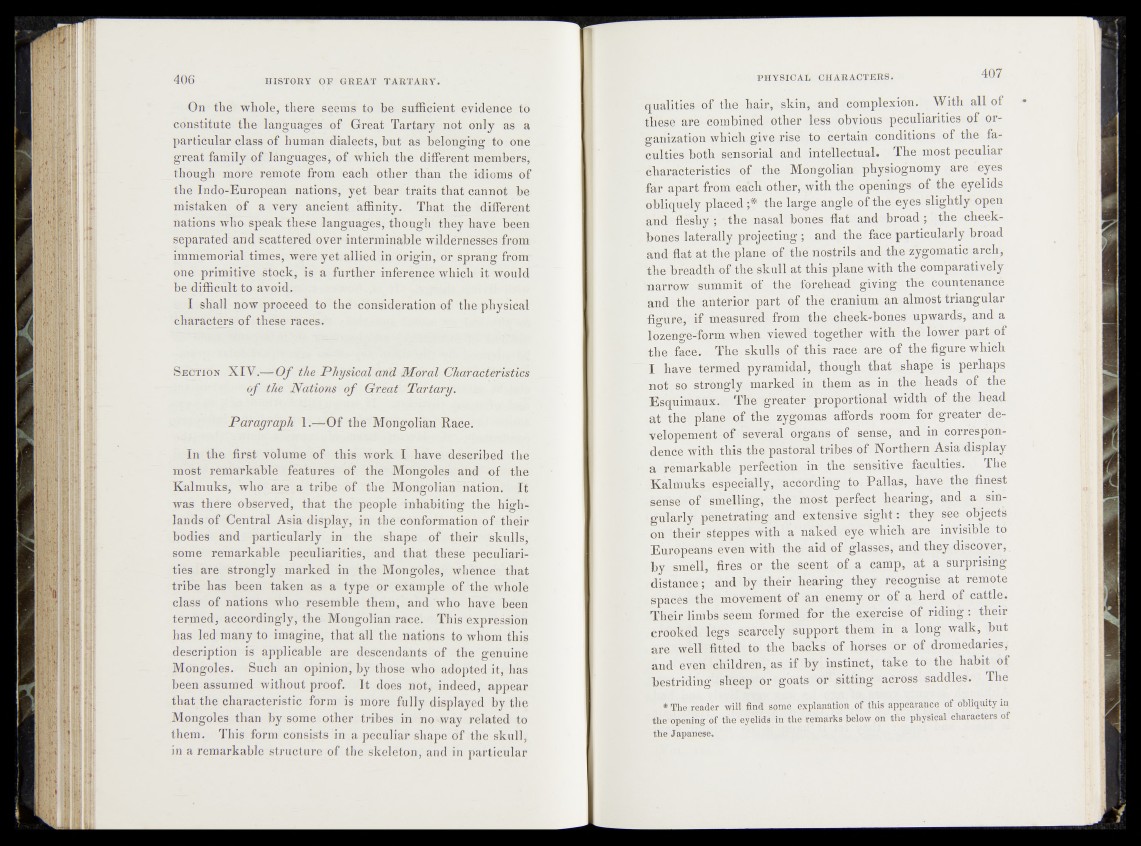
406 HISTORY QJ? GREAT TARTARY.
On the whole, there seems to he sufficient evidence to
constitute the languages, of Great Tartary not only as a
particular class of human dialects, hut as belonging to one
great family of languages, of which the different members,
though moré remote from each other than the idioms of
the Indo-European nations, yet bear traits that cannot be
mistaken of a very ancien t„ affinity. That the different
nations who speak these languages, though they have been
separated and scattered over interminable wildernesses from
immemorial times, were yet allied in origin, or sprang from
one primitive stock, is a further inference which it would
be difficult to avoid..
I shall now proceed to the consideration of the physical
characters of these races.
S ection XIV.—Of the Physical and Moral Characteristics
of the Nations of Ghxat Tartary.
Paragraph 1 .—Of the Mongolian Race.
In the first volume of this work I have described the
most remarkable features of the Mongoles and of the
Kalmuks, who are a tribe of the Mongolia^ nationr It
was there observed, that the people inhabiting the highlands
of Central Asia display, in the conformation of their
bodies and particularly in the ?shape of their skulls,
some remarkable peculiarities, and that these peculiarities
are. strongly marked in the Mongoles, whence that
tribe has been taken as a type or example of the whole
class of nations who resemble them, and who have been
termed, accordingly, the Mongolian race. This expression
has led many to imagine, that all the nations to whom this
description is applicable are descendants of the genuine
Mongoles. Such an opinion, by those who adopted it, has
been assumed without proof. It does not, indeed, appear
that the characteristic form is more fully displayed by the
Mongoles than by some other tribes in no way related to
them. This form consists in a peculiar shape of the skull,
in a remarkable structure of the skeleton, and in particular
PHYSICAL CHARACTERS. 407
qualities of the hair, skin, and complexion. With all of
these are-combined other less.mbvioira peculiarities of organization
which give rise- to certain conditions of the faculties,
both sensorial and intellectual. The most peculiar
characteristics. of the Mongolian physiognomy are eyes
far apart from eaM‘©ther,.^vith'fhe openings* of the eyelids
obliquely placed;* the larf$e} angle of the eyes slightly open
and flesl%f|h the nasal bones fiat and broad; ' the cheekbones
laterally projecting ; and thé .’face particularly broad
and flat at the plane, of- ^he nostrils and the zygomatic arch,
the breadth of thfeskull at this plane with-the comparatively
marrow summit of Ae^forehead,7 gividgithe«countenance
and .the • anterior part of the cranium an almost triangular
figure, if measured frfom, the cheek-bones upwards, and a
lozenge-form when viewed together with th row e r part of
the face. The skulls of this^ace are p i the figure which
I have termed pyramidal, though that .shape is perhaps
not so strhngly marked in them as in the^Jieads of . the
Esquimaux. The greatei^proportional width of the head
at the plane* of the zygomas affords, room for greater de-
vel'èpement of several organs of sense, anehjn eorresp|n-
dencWjwith this the pastoral trih^%f Northern Asia display
a ^remarkable perfection in the sensitive faculties;. The
Kalmuks [especially, according to Pallas, ha^e dhe finest
sense of smelling, the most-perfect hearing,, apd a ^singularly
penetrating and extensive sight: they sée obj^élff
óii'"their eteppes---with a naked which are iafdsihT^to
European! Jven with the aid of glasses, and they di^ggyer,
by smell, fires, or the sceni, of- a camp, pt. a surprising
distance ; and by their hearing they recognise at remote
épacès the movement of an enemy Or,.,of a-herd of cattle,;
Their limbs seein formed for the exercise 'of rjjïdng : their
Crooked lègs scarcely support-them hr a long walk, but
are well fitted to the backs of horses or of dromedaries/
and éven children, as. if by ..instinct, take to the» habit óf
bestriding -sheep or goats or sitting%cröss saddles. The
* The reader will finu sptoè e^ltoa|Ln,<)f ^Ms'.Wpea^apee erf obliquity in
the-'opening of the eyelids fin the* remarks below on the physical characters of
the Japanese.